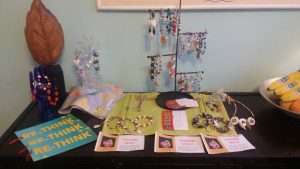It is late spring. The flowers are bursting through moist soil with daffodils and tulips, and the sweet smell of apple blossoms lingers. All across America, in high school classrooms everywhere, transition plans are in progress for teenagers with disabilities who have an IEP (Individual Education Plan). These transition plans are designed to prepare future graduates for adulthood, but could they be missing a simple but effective tool for transition?
Business Cards are Community Connection Tools
It’s a simple thing, a business card. Typically, most people carry them, especially if they are interested in working. However, most people with disabilities don’t. Should they?
As adults, part of the enculturation process into the world is seeking employment to build a productive and meaningful life. Most people with disabilities have similar aspirations if given the opportunity and support. As students leave the education system and begin to transition into adulthood, young adults with disabilities go through an Individual Educational Plan (IEP) or a Transition Planning (ITP) process.
Can Business Cards Be Part of Graduation?
However, the simple yet inexpensive idea of creating a business card as part of transitioning from school to work and adult life is rarely considered by the transition team n preparing these young people for life outside school.
Why is it important to have a business card? Ask yourself, why do you have one?
Here is why I think people with disabilities should carry a business card with them even though they might not have a business or a job.
Perception is everything.
A card, business or personal, implies competence. To illustrate this point, I want to tell you how this inexpensive, little-used strategy changed Mikelle’s life.
It started one day after Mikelle lived in her condo near downtown Denver for almost five years, where young professionals her age, in their twenties and thirties, also owned condos in her building. They have seen Mikelle in the elevator or passing through the lobby for years and headed out for coffee. Often, they engage in light, superficial conversation with her. The prevalent perception of Mikelle was she is a pleasant, lively person with a disability surrounded by caregivers to help her access her community and live in her condo.
That is until the day when a box from Vistaprint arrived. Quickly, Mikelle loaded up her ruby-red wallet with a handful of her brand new business cards that show off her new book, Shining Beautiful, The Brilliance of Community in Action.
With a simple smile, she took the initiative to give her cards to those who never knew she worked. The conversation changed from “How are you today?” “Tell me about your business.” afterward, it went to “I will check it out.” after that, “Let’s connect on Facebook.” To, “Do you have some of the jewelry with you?”
Business cards are the bridge to a more extensive conversation.
The exchange of business cards stimulated a more significant, deeper dialogue, implying action. I have goals. I am going places—just like you.
Once Mikelle gives the new people she meets her business card, a new-found respect emerges, common ground is found, and the realization that Mikelle is more like them than they had thought. Those conversations often lead to a sale of her book or her jewelry.
A business card comes out of the wallet, and money goes into it—a perfect day in Mikelle’s world.
The other day, Mikelle and I were hungering for a cappuccino and a blended iced drink. The afternoon warmed to a comfortable sixty degrees, so we sought one with a lovely patio in the neighborhood. I opened my laptop to write as the sun warmed us down to the bone. I relaxed into my work, and Mikelle dug through her turquoise purse, looking for the red wallet. In minutes, a business card was in her hand. She reached for the control on her wheelchair and zipped over to a neighboring table, stopping just short of two people: a woman with bleached blonde hair and a young man.
Mikelle extended her card to the woman to market her jewelry business and perhaps solicit a “Like” for her Facebook page. Startled, the woman reacted, shaking her head.
She said, “I am sorry. I don’t have any money today.” Initially, she thought Mikelle was begging for money. However, Mikelle persisted. The woman glanced at the card and said, “Wow. You have your own business?”
Mikelle showed her the portfolio of bracelets she carries for the just-in-case sale. Then, one by one, she opened the pastel-colored organza bags, complementing her on the bracelets each time. Finally, she came to a necklace with a turquoise heart pendant.
Sighing, she said. “My daughter will love this; her birthday is next month. How much do you want for it?”
The power of a business card not only changed Mikelle from a beggar to a businesswoman. It changed the woman and her companion’s perception of what someone with a significant disability can do.
For ten dollars or less, why wouldn’t we have every student graduate with a business card in their hands? More of our graduating students would have a greater chance at a meaningful and productive life.
ACTION STEP: At the next IEP/ITP meeting, you attend, discuss the topic, take an active role, and try it.
Let us know what happens!

